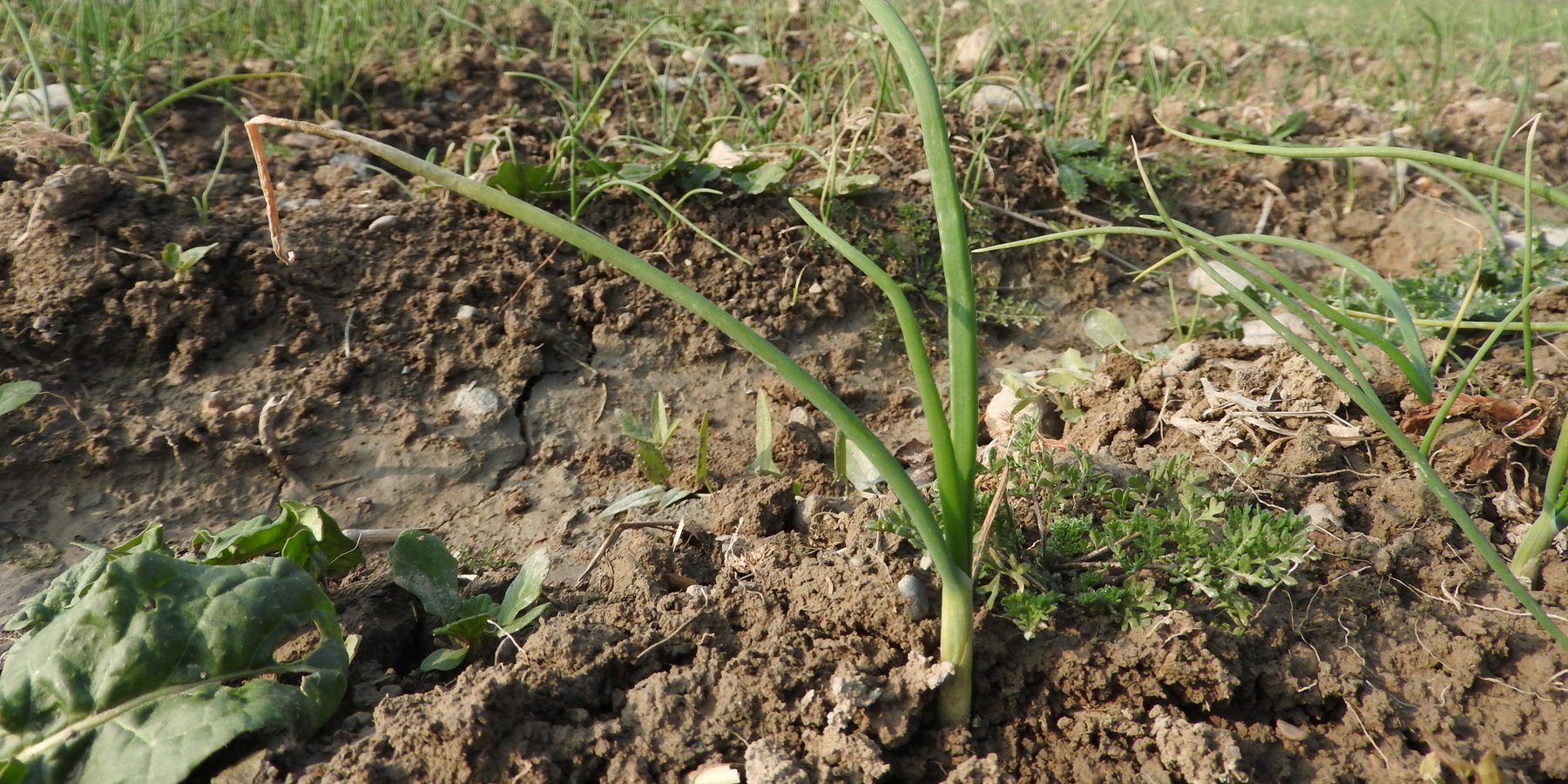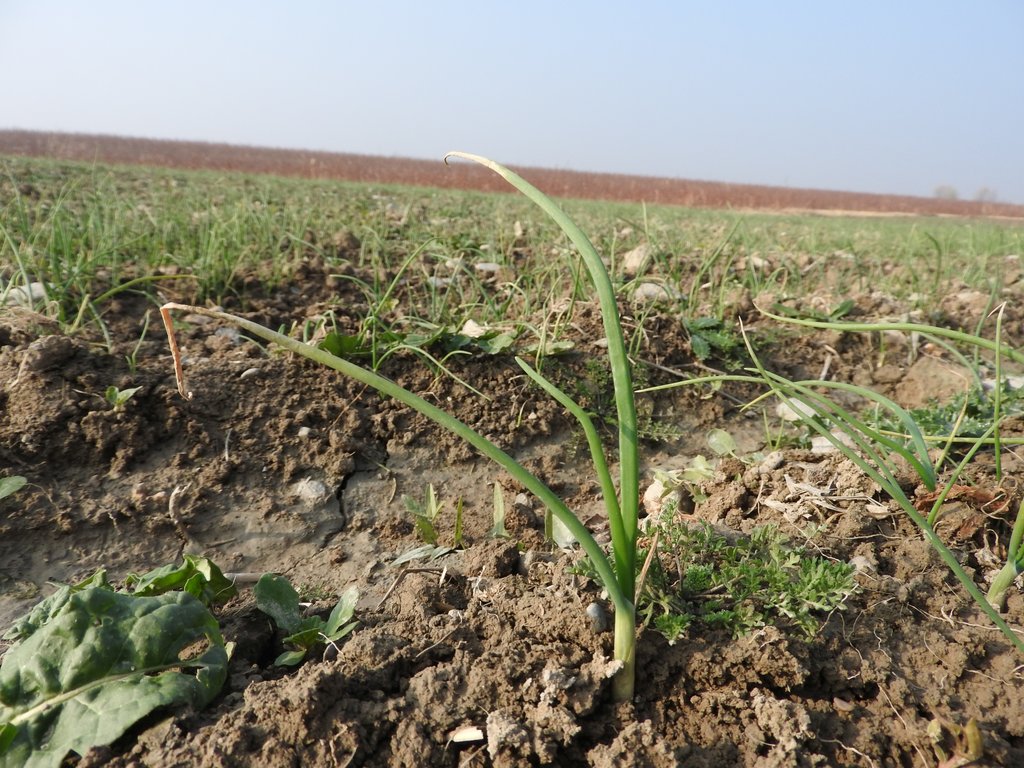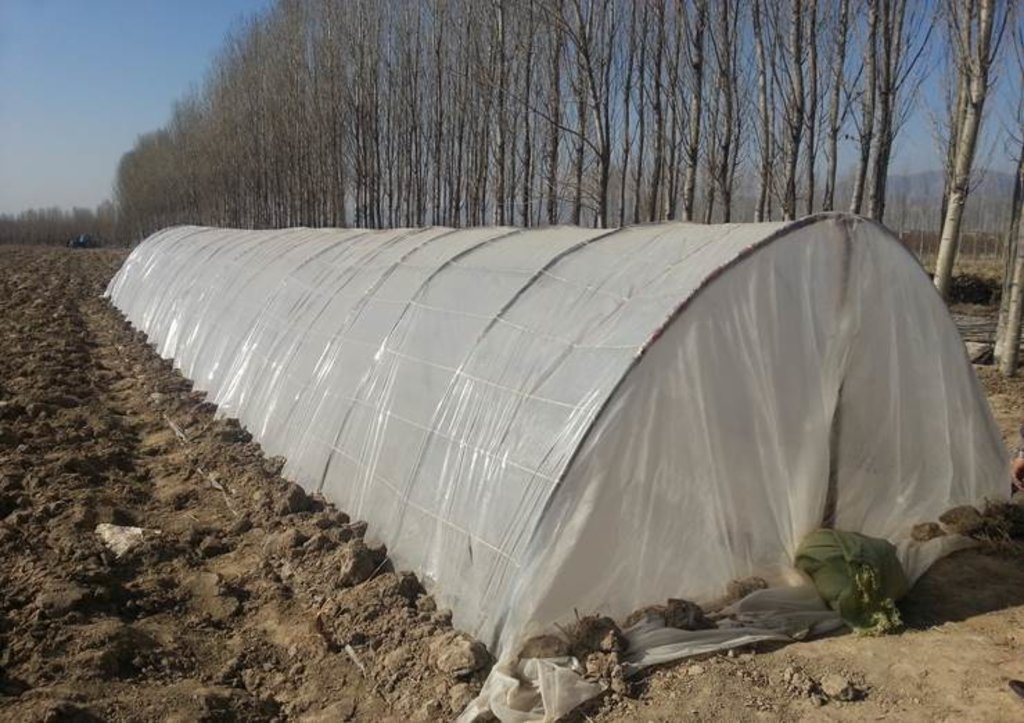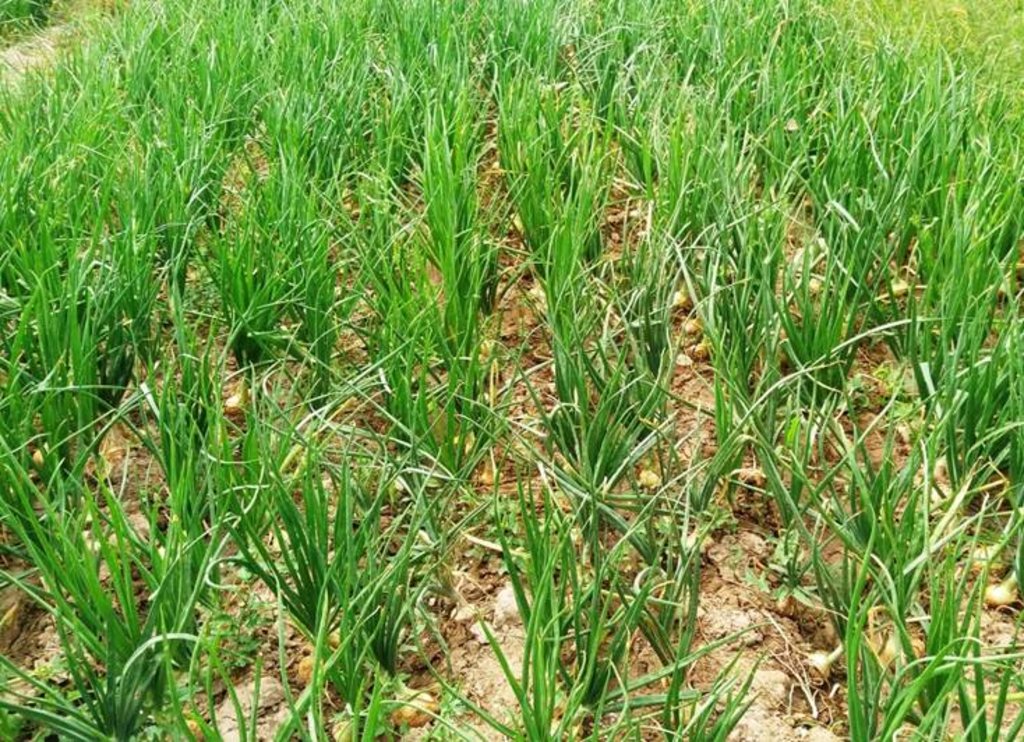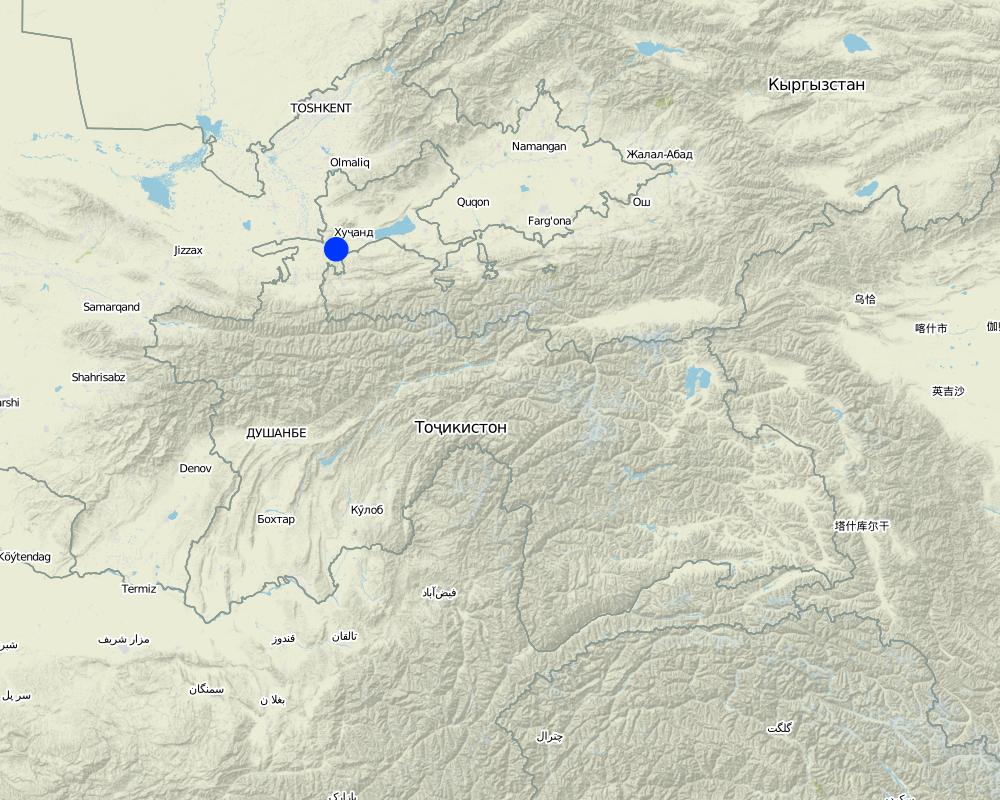Onion production by greenhouse propagation and transplantation [Tadjikistan]
- Création :
- Mise à jour :
- Compilateur : Stefan Michel
- Rédacteur : –
- Examinateur : Umed Vahobov
Выращивание лука рассадным способом
technologies_4296 - Tadjikistan
Voir les sections
Développer tout Réduire tout1. Informations générales
1.2 Coordonnées des personnes-ressources et des institutions impliquées dans l'évaluation et la documentation de la Technologie
Personne(s)-ressource(s) clé(s)
Spécialiste GDT:
Negmatov Negmatjon
Deutsche Gesellschaft für Internationale Zusammenarbeit (GIZ)
Tadjikistan
Spécialiste GDT:
Haydarov Abdusattor
NGO Neksigol
Tadjikistan
Nom du projet qui a facilité la documentation/ l'évaluation de la Technologie (si pertinent)
Strengthening of Livelihoods through Climate Change Adaptation in Kyrgyzstan and TajikistanNom du ou des institutions qui ont facilité la documentation/ l'évaluation de la Technologie (si pertinent)
GIZ Tajikistan (GIZ Tajikistan) - Tadjikistan1.3 Conditions relatives à l'utilisation par WOCAT des données documentées
Le compilateur et la(les) personne(s) ressource(s) acceptent les conditions relatives à l'utilisation par WOCAT des données documentées:
Oui
1.4 Déclaration sur la durabilité de la Technologie décrite
Est-ce que la Technologie décrite ici pose problème par rapport à la dégradation des terres, de telle sorte qu'elle ne peut pas être déclarée comme étant une technologie de gestion durable des terres?
Non
1.5 Référence au(x) Questionnaires sur les Approches de GDT (documentées au moyen de WOCAT)
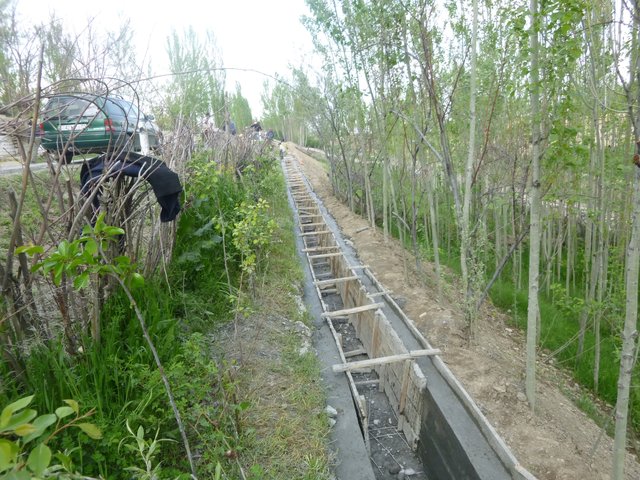
Increased efficiency of irrigation water use to address … [Tadjikistan]
Climate change impact contributes to irrigation water shortage. The approach of improving irrigation water delivery, distribution and use prevents irrigation water losses and increases the productivity per amount of irrigation water available.
- Compilateur : Stefan Michel
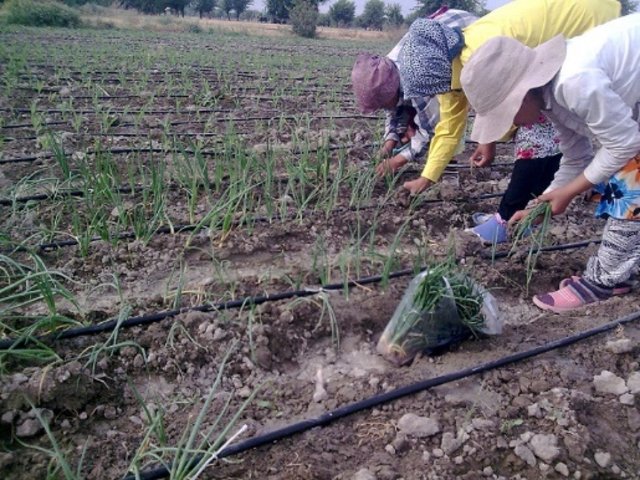
Integrated farming on irrigated lands for adaptation to … [Tadjikistan]
Irrigated agriculture faces challenges from climate change impact and growing competition for irrigation water. The approach to get "more crop per drop" reduces the adverse effect of these impacts and improves the income of farmers.
- Compilateur : Stefan Michel
2. Description de la Technologie de GDT
2.1 Courte description de la Technologie
Définition de la Technologie:
Onion seeds are sown in sheeting greenhouses, where the onion seedlings are propagated. The seedlings are then replanted in the open field. This makes them less prone to extreme weather events and provides higher yield of better quality.
2.2 Description détaillée de la Technologie
Description:
The technology of greenhouse propagation of onion plants and transplantation is applied in intensive, irrigation dependent agricultural systems. The technology is based on sowing of onion seeds in a sheeting greenhouse, where the seedlings grow for 45 days. Afterwards the onion seedlings are replanted in the open field. By this technology the sensitive seedlings are propagated in a protective environment making them less vulnerable to unfavorable weather conditions, like late freezing or rainstorms. Due to ongoing climate change weather conditions become less predictable and extreme events become more frequent.
The propagation of onions in the greenhouse requires substantially less seeds than traditional hand sowing in the field – 4 kg/ha onion field instead of 16-18 kg, i.e. saving 75-77%. Furthermore the propagation of onion seedlings in greenhouses with transplanting allows for a reduced input of pesticides and fertilizer compared to sowing in the field. This reduction of agrochemical input is related to the small area and favorable conditions in the greenhouse during the propagation of the seedlings.
The technology requires the preparation of the field in fall with 30 cm deep ploughing, harrowing and planning (молование). Afterwards the furrows for planting are made. Complex mineral fertilizer “NitroAmmoPhosKa” (N 16%, P2O5 16%, K2O 16%) or “DiAmmoPhosKa” (N 16%, P 16%, K 16%) in an amount of 75 kg per ha is applied before the transplanting.
The onion seeds are in mid-March sown in a sheeting greenhouse with 4 kg seeds on 100 m². Together with the seeds 3 kg “NitroAmmoPhosKa” and some dung are applied as fertilizer. After 45 days the onion seedlings have reached the stage of three real leaves and are in their optimum growth stage for replanting into the field. The seedlings in the three-leaf stage are by hand planted on the open ground of the prepared as described field.
During the growth period the seedlings are one time weeded and fertilized as follows: i) during planting 75 kg/ha “NitroAmmoPhosKa” is applied; ii) another 100 kg/ha “NitroAmmoPhosKa” is applied in form of supplementary fertilizing (подкормка). Also other fertilizer has been applied in form of supplementary fertilizing (подкормка) 400 kg/ha “Selitra”, 200 kg/ha “Ammophos” and 200 kg/ha “Karbamid (46)”. The onion has also been treated with various pesticides. The field is 10 times irrigated during the vegetation season, requiring 8000 m³ of irrigation water.
The yield on test plots was 91,300 kg/ha. The harvested onions are more homogenous in size thus better marketable than those propagated conventionally.
The benefit of the technology is the reduced amount of seeds required, reduced costs of pesticides and fertilizer. Despite the costs of materials and the effort needed to establish the greenhouse and the additional work for transplanting the seedlings, the technology provides an economic net benefit to the farmer. In testing plots the net profit of traditional onion cultivation was 76% while with greenhouse propagation and transplanting a net profit of 192% would be achieved. Greenhouse propagation also protects the seedlings from failure caused by extreme weather events, which become more frequent due to climate change, and thus reduce the risk for the farmers.
2.3 Photos de la Technologie
2.5 Pays/ région/ lieux où la Technologie a été appliquée et qui sont couverts par cette évaluation
Pays:
Tadjikistan
Région/ Etat/ Province:
Sughd region
Autres spécifications du lieu:
J. Rasulov district
Spécifiez la diffusion de la Technologie:
- appliquée en des points spécifiques ou concentrée sur une petite surface
Est-ce que les sites dans lesquels la Technologie est appliquée sont situés dans des zones protégées en permanence?
Non
Commentaires:
So far only single farmers apply the technology.
Map
×2.6 Date de mise en œuvre de la Technologie
Indiquez l'année de mise en œuvre:
2016
2.7 Introduction de la Technologie
Spécifiez comment la Technologie a été introduite: :
- au cours d'expérimentations / de recherches
- par le biais de projets/ d'interventions extérieures
Commentaires (type de projet, etc.) :
Demonstration plots have been established and monitored by the NGO Neksigol with support by the GIZ project.
3. Classification de la Technologie de GDT
3.1 Principal(aux) objectif(s) de la Technologie
- améliorer la production
- s'adapter au changement et aux extrêmes climatiques et à leurs impacts
- créer un impact économique positif
3.2 Type(s) actuel(s) d'utilisation des terres, là où la Technologie est appliquée
Les divers types d'utilisation des terres au sein du même unité de terrain: :
Non

Terres cultivées
- Cultures annuelles
Cultures annuelles - Précisez les cultures:
- céréales - blé de printemps
- cultures de plantes à fibres - coton
- cultures oléagineuses - tournesol, colza, autres
- légumes - légumes-racines (carotte, oignon, betterave, autres)
Nombre de période de croissance par an: :
- 1
Est-ce que la rotation des cultures est appliquée?
Oui
3.3 Est-ce que l’utilisation des terres a changé en raison de la mise en œuvre de la Technologie ?
Est-ce que l’utilisation des terres a changé en raison de la mise en œuvre de la Technologie ?
- Non (Passez à la question 3.4)
3.4 Approvisionnement en eau
Approvisionnement en eau des terres sur lesquelles est appliquée la Technologie:
- pleine irrigation
3.5 Groupe de GDT auquel appartient la Technologie
- amélioration des variétés végétales, des races animales
- imoroved vegetable cultivation
3.6 Mesures de GDT constituant la Technologie

pratiques agronomiques
- A5: Gestion des semences, amélioration des variétés
- A7: Autres
3.8 Prévention, réduction de la dégradation ou réhabilitation des terres dégradées
Spécifiez l'objectif de la Technologie au regard de la dégradation des terres:
- non applicable
4. Spécifications techniques, activités, intrants et coûts de mise en œuvre
4.2 Informations générales sur le calcul des intrants et des coûts
Spécifiez la manière dont les coûts et les intrants ont été calculés:
- par superficie de la Technologie
Indiquez la taille et l'unité de surface:
hectare
autre/ monnaie nationale (précisez):
TJS
Indiquez le taux de change des USD en devise locale, le cas échéant (p.ex. 1 USD = 79.9 réal brésilien): 1 USD = :
8,0
Indiquez le coût salarial moyen de la main d'œuvre par jour:
20-50
4.4 Coûts et intrants nécessaires à la mise en place
Commentaires:
We did not differentiate establishment and recurrent activities, as this is a technology to be integrated in the overall cycle of agricultural works.
4.5 Activités d'entretien/ récurrentes
| Activité | Calendrier/ fréquence | |
|---|---|---|
| 1. | Preparation of greenhouse field (100 m²) | February-March/once per annum |
| 2. | Establishment of sheeting greenhouse | February-March/once per annum |
| 3. | Sowing onion seeds and care | March-April/once per annum |
| 4. | Transplanting of seedlings | End April/once per annum |
| 5. | Ploughing of field, harrowing, planning, making furrows | Before transplanting/once per annum |
| 6. | Fertilizing | Before transplanting, during vegetation |
| 7. | Irrigation | 10 times during vegetation season |
| 8. | Application of pesticides | 5 times during vegetation season |
| 9. | Weeding | 3 times during vegetation season |
| 10. | Harvest | Once per annum |
Commentaires:
We did not differentiate establishment and recurrent activities, as this is a technology to be integrated in the overall cycle of agricultural works.
4.6 Coûts et intrants nécessaires aux activités d'entretien/ récurrentes (par an)
| Spécifiez les intrants | Unité | Quantité | Coûts par unité | Coût total par intrant | % des coût supporté par les exploitants des terres | |
|---|---|---|---|---|---|---|
| Main d'œuvre | Preparation of greenhouse field (100 m²) | person | 1,0 | 50,0 | 50,0 | 100,0 |
| Main d'œuvre | Establishment of greenhouse | person | 1,0 | 50,0 | 50,0 | 100,0 |
| Main d'œuvre | Sowing onion seeds and care (over 45 days) | person | 2,0 | 50,0 | 100,0 | 100,0 |
| Main d'œuvre | Agrotechnical works | ha | 1,0 | 820,0 | 820,0 | 100,0 |
| Equipements | Sheeting | m | 50,0 | 1,0 | 50,0 | 100,0 |
| Matériel végétal | Seeds | kg | 4,0 | 685,0 | 2740,0 | 100,0 |
| Matériel végétal | Transplanting | 1,0 | 1520,0 | 1520,0 | 100,0 | |
| Engrais et biocides | Politrin ka | l | 1,0 | 200,0 | 200,0 | 100,0 |
| Engrais et biocides | Mospilan | kg | 0,4 | 100,0 | 40,0 | 100,0 |
| Engrais et biocides | Goal | l | 0,6 | 220,0 | 132,0 | 100,0 |
| Engrais et biocides | Other pesticides | Total | 1,0 | 2371,0 | 2371,0 | 100,0 |
| Engrais et biocides | Ammonium Nitrate | 50 kg | 8,0 | 120,0 | 960,0 | 100,0 |
| Engrais et biocides | NitroAmmoPhosKa | 50 kg | 4,8 | 240,0 | 1152,0 | 100,0 |
| Engrais et biocides | Ammophos | 50 kg | 4,0 | 160,0 | 640,0 | 100,0 |
| Engrais et biocides | Karbamid (46) | 50 kg | 4,0 | 130,0 | 520,0 | 100,0 |
| Matériaux de construction | 2,0 | |||||
| Autre | Irrigation | times | 10,0 | 50,0 | 500,0 | 100,0 |
| Autre | Irrigation water | m³ | 8000,0 | 0,018 | 144,0 | 100,0 |
| Autre | Application of pesticides | times | 5,0 | 50,0 | 250,0 | 100,0 |
| Autre | Weeding | times | 3,0 | 500,0 | 1500,0 | 100,0 |
| Autre | Harvest | ha | 1,0 | 4000,0 | 4000,0 | 100,0 |
| Autre | Miscellaneous expenses | 1,0 | 1000,0 | 1000,0 | 100,0 | |
| Coût total d'entretien de la Technologie | 18739,0 | |||||
| Coût total d'entretien de la Technologie en dollars américains (USD) | 2342,38 | |||||
Commentaires:
We did not differentiate establishment and recurrent activities, as this is a technology to be integrated in the overall cycle of agricultural works.
4.7 Facteurs les plus importants affectant les coûts
Décrivez les facteurs les plus importants affectant les coûts :
Transplanting is an important additional cost factor, compared to conventional sowing. However, costs for seeds is lower despite of use of higher quality seeds of certified sorts.
5. Environnement naturel et humain
5.1 Climat
Précipitations annuelles
- < 250 mm
- 251-500 mm
- 501-750 mm
- 751-1000 mm
- 1001-1500 mm
- 1501-2000 mm
- 2001-3000 mm
- 3001-4000 mm
- > 4000 mm
Spécifiez la pluviométrie moyenne annuelle (si connue), en mm:
246,00
Indiquez le nom de la station météorologique de référence considérée:
Mehrobod
Zone agro-climatique
- semi-aride
5.2 Topographie
Pentes moyennes:
- plat (0-2 %)
- faible (3-5%)
- modéré (6-10%)
- onduleux (11-15%)
- vallonné (16-30%)
- raide (31-60%)
- très raide (>60%)
Reliefs:
- plateaux/ plaines
- crêtes
- flancs/ pentes de montagne
- flancs/ pentes de colline
- piémonts/ glacis (bas de pente)
- fonds de vallée/bas-fonds
Zones altitudinales:
- 0-100 m
- 101-500 m
- 501-1000 m
- 1001-1500 m
- 1501-2000 m
- 2001-2500 m
- 2501-3000 m
- 3001-4000 m
- > 4000 m
Indiquez si la Technologie est spécifiquement appliquée dans des:
- non pertinent
5.3 Sols
Profondeur moyenne du sol:
- très superficiel (0-20 cm)
- superficiel (21-50 cm)
- modérément profond (51-80 cm)
- profond (81-120 cm)
- très profond (>120 cm)
Texture du sol (de la couche arable):
- moyen (limoneux)
Texture du sol (> 20 cm sous la surface):
- moyen (limoneux)
Matière organique de la couche arable:
- moyen (1-3%)
5.4 Disponibilité et qualité de l'eau
Profondeur estimée de l’eau dans le sol:
< 5 m
Disponibilité de l’eau de surface:
moyenne
Qualité de l’eau (non traitée):
uniquement pour usage agricole (irrigation)
La qualité de l'eau fait référence à:
à la fois les eaux souterraines et de surface
La salinité de l'eau est-elle un problème? :
Non
La zone est-elle inondée?
Non
5.5 Biodiversité
Diversité des espèces:
- faible
Diversité des habitats:
- faible
5.6 Caractéristiques des exploitants des terres appliquant la Technologie
Sédentaire ou nomade:
- Sédentaire
Orientation du système de production:
- commercial/ de marché
Niveau relatif de richesse:
- moyen
Individus ou groupes:
- individu/ ménage
- coopérative
Niveau de mécanisation:
- mécanisé/ motorisé
Genre:
- femmes
- hommes
Age des exploitants des terres:
- jeunes
- personnes d'âge moyen
5.7 Superficie moyenne des terres utilisées par les exploitants des terres appliquant la Technologie
- < 0,5 ha
- 0,5-1 ha
- 1-2 ha
- 2-5 ha
- 5-15 ha
- 15-50 ha
- 50-100 ha
- 100-500 ha
- 500-1 000 ha
- 1 000-10 000 ha
- > 10 000 ha
Cette superficie est-elle considérée comme de petite, moyenne ou grande dimension (en se référant au contexte local)?
- moyenne dimension
Commentaires:
Technology can be applied by small-holders as well as by large farms.
5.8 Propriété foncière, droits d’utilisation des terres et de l'eau
Propriété foncière:
- état
Droits d’utilisation des terres:
- loué
- Water management organization
Est-ce que les droits d'utilisation des terres sont fondés sur un système juridique traditionnel?
Non
5.9 Accès aux services et aux infrastructures
santé:
- pauvre
- modéré
- bonne
éducation:
- pauvre
- modéré
- bonne
assistance technique:
- pauvre
- modéré
- bonne
emploi (par ex. hors exploitation):
- pauvre
- modéré
- bonne
marchés:
- pauvre
- modéré
- bonne
énergie:
- pauvre
- modéré
- bonne
routes et transports:
- pauvre
- modéré
- bonne
eau potable et assainissement:
- pauvre
- modéré
- bonne
services financiers:
- pauvre
- modéré
- bonne
6. Impacts et conclusions
6.1 Impacts sur site que la Technologie a montrés
Impacts socio-économiques
Production
production agricole
Quantité avant la GDT:
40.000 kg/ha
Quantité après la GDT:
91,300 kg/ha
qualité des cultures
Commentaires/ spécifiez:
Higher percentage of onions of standard size and quality
Revenus et coûts
dépenses pour les intrants agricoles
Commentaires/ spécifiez:
Reduction of fertilizer application: by 50% (400 kg) Ammonium Nitrate and 52% (260 kg) NitroAmmoPhosKa
revenus agricoles
Quantité avant la GDT:
14,266 TJS/ha
Quantité après la GDT:
36.041 TJS/ha
Commentaires/ spécifiez:
The net profit while applying this technololgy is 192% of the costs, compared with 76% with applying conventional methods.
Impacts écologiques
Autres impacts écologiques
Onion seedlings less prone to extreme weather events, like late freezing and snow
6.3 Exposition et sensibilité de la Technologie aux changements progressifs et aux évènements extrêmes/catastrophes liés au climat (telles que perçues par les exploitants des terres)
Extrêmes climatiques (catastrophes)
Catastrophes météorologiques
| Comment la Technologie fait-elle face à cela? | |
|---|---|
| pluie torrentielle locale | bien |
| tempête de neige locale | bien |
| tempête de vent locale | pas bien |
Catastrophes climatiques
| Comment la Technologie fait-elle face à cela? | |
|---|---|
| vague de froid | très bien |
6.4 Analyse coûts-bénéfices
Quels sont les bénéfices comparativement aux coûts de mise en place (du point de vue des exploitants des terres)?
Rentabilité à court terme:
positive
Rentabilité à long terme:
positive
Quels sont les bénéfices comparativement aux coûts d'entretien récurrents (du point de vue des exploitants des terres)?
Rentabilité à court terme:
positive
Rentabilité à long terme:
positive
6.5 Adoption de la Technologie
- 1-10%
De tous ceux qui ont adopté la Technologie, combien d'entre eux l'ont fait spontanément, à savoir sans recevoir aucune incitation matérielle, ou aucune rémunération? :
- 91-100%
6.6 Adaptation
La Technologie a-t-elle été récemment modifiée pour s'adapter à l'évolution des conditions?
Non
6.7 Points forts/ avantages/ possibilités de la Technologie
| Points forts/ avantages/ possibilités du point de vue du compilateur ou d'une autre personne ressource clé |
|---|
| Reduced risk, reduced amount of seeds |
| Increased yield of better quality |
| As onion is an important crop in the area there is high potential for the application of the technology |
6.8 Faiblesses/ inconvénients/ risques de la Technologie et moyens de les surmonter
| Faiblesses/ inconvénients/ risques du point de vue du compilateur ou d'une autre personne ressource clé | Comment peuvent-ils être surmontés? |
|---|---|
| None | |
| High workload required for transplanting | Adequate organization of farm works. Attraction of temporary labor. |
| Sheeting of greenhouses only suitable for one season, no recycling opportunities - risk of massive littering of the environment. | Establishment of system for collection of used sheeting and its recycling or energetic use. |
7. Références et liens
7.1 Méthodes/ sources d'information
- visites de terrain, enquêtes sur le terrain
- interviews/ entretiens avec les spécialistes/ experts de GDT
- compilation à partir de rapports et d'autres documents existants
Documentation by the project: information sheet, excel files for calculation of gross margin specifying inputs and yield.
Quand les données ont-elles été compilées (sur le terrain)?
29/11/2018
Liens et modules
Développer tout Réduire toutLiens

Increased efficiency of irrigation water use to address … [Tadjikistan]
Climate change impact contributes to irrigation water shortage. The approach of improving irrigation water delivery, distribution and use prevents irrigation water losses and increases the productivity per amount of irrigation water available.
- Compilateur : Stefan Michel

Integrated farming on irrigated lands for adaptation to … [Tadjikistan]
Irrigated agriculture faces challenges from climate change impact and growing competition for irrigation water. The approach to get "more crop per drop" reduces the adverse effect of these impacts and improves the income of farmers.
- Compilateur : Stefan Michel
Modules
Aucun module trouvé


